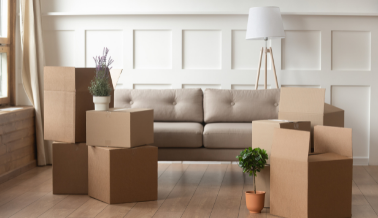Ron’s Thoughts: eCommerce Drop Shipping for Furniture Retail

July 21, 2021
In my last blog, I talked about why furniture retailers need eCommerce stores. Today, we’ll talk about the next step: drop shipping.
Once your eCommerce storefront is generating orders, adding drop shipping can help your business gain efficiencies. With drop shipping, you have the ability to provide more product to the customer, without having to deal warehousing inventory or fulfilling orders.
Here’s how it works: when the consumer buys from you, you pass that information to the vendor, and they ship it to the customer from their inventory. But they can use your box and your logo and your FedEx or UPS number so you can track the product. To the customer, that product is coming from you, but you don’t have to warehouse it or ship it, and that frees up space in both your warehouse and showroom floor.
Some people call it an “endless” aisle, but I think of it as an extended aisle. So today, you may have 15 pieces from a vendor in your stores, but you may want to take that to 50 on your eCommerce site. With drop shipping, you can do that.
To succeed with drop shipping for your eCommerce site, you need to be able to control a few things.
First is real-time inventory visibility. For example, if my wife spends 30 minutes on a website looking around and she orders a piece and two hours later, you come back and say “oops, that’s not in stock,” she’s not going back to your site. Ever.
One way to get up-to-date inventory information from your suppliers is via EDI. Most commonly, suppliers use a transaction called the EDI 846 Inventory Inquiry/Advice, which can break down inventory availability by SKU and location. You can request that from your vendors or ask them to send at a pre-defined frequency, so you are getting regular updates.
Many ERP systems can’t handle the EDI 846 transaction yet. But at TrueCommerce ecUtopia, we are able to accept the incoming EDI 846 and store it on our Dashboard. From there, you can view it, or download it, or push it to a system that does accept the transaction, like your eCommerce storefront.
This brings us back to treating your eCommerce store like a location. In your retail stores, you have someone who manages inventory—you need that for eCommerce drop shipping, too. Someone needs to be in charge of those 846 documents, to make sure the storefront is always up to date on inventory availability.
Another thing is fulfillment. You need to set the expectations with your vendors, and make sure they are delivering, because you don’t want a broken customer promise.
First, you need to build the plan, by deciding on standards for drop shipping fulfillment. You’ll also need to get the right people involved for management and get a budget for it. And again, executive support to the project is essential. This isn’t a throw-away, back-office thing. It takes the same attention as opening a new warehouse location and setting it up to get ready to ship.
EDI helps here too, but some of your suppliers might not have EDI yet. You can make that a requirement for working with your company, but if you want to work with the smaller or newer suppliers, you might also want to look at a solution like the TrueCommerce ecUtopia web portal which allows small to mid-size suppliers to be fully EDI compliant at a low cost.
The last thing you have to think about is, there’s a return factor in drop shipping, and returns are not easy, especially in furniture. And they can’t be swept under the rug. So, guess what: you need a plan for that too.
The best way to build a return policy is to discuss ideas with your peers who have done this before you. You don’t have to recreate the wheel, because there are plenty of ways to handle returns. Some retailers bring returned items back to their warehouse or DC and manage everything themselves. Others use reverse logistics partners to have products brought back. Depending on the product and where the manufacturer is located, some drop ship retailers choose to have items sent back directly to the supplier.
All those choices impact the cost of returns, for you, for your suppliers, and in many cases, for your customers. So, choosing the right returns plan for your business is important if you want to be successful with drop shipping.
Most of the retailers who treat a website right, find it becomes their number one store. Adding drop shipping to your eCommerce operations can help your business expand even more, as long as you do it right. If you need help getting started or managing your eCommerce and drop shipping business, reach out to TrueCommerce ecUtopia. Our team is ready with the solutions and support you need to grow.
See How RC Willey Saves Time and Reduces Errors in Their Supply Chain
With EDI, RC Willey can automate order processing to reduce delays and get products to customers faster than ever.
About the Author: Ron Sellers, co-founder and chief revenue officer of TrueCommerce ecUtopia, is a technology advocate and leader for the home furnishings industry. With more than 25 years of industry-related experience, he offers significant expertise as a committee member of the Home Furnishings Association (HFA) and sits on the Executive Advisory Council for WithIt, a women’s leadership development network for the home and furnishings industries. When Ron is outside of the office, he can be found on his Harley Davidson cruising the streets.
Share this post:
Stay ahead of the competition
Get expert supply chain insights delivered directly to your inbox weekly.